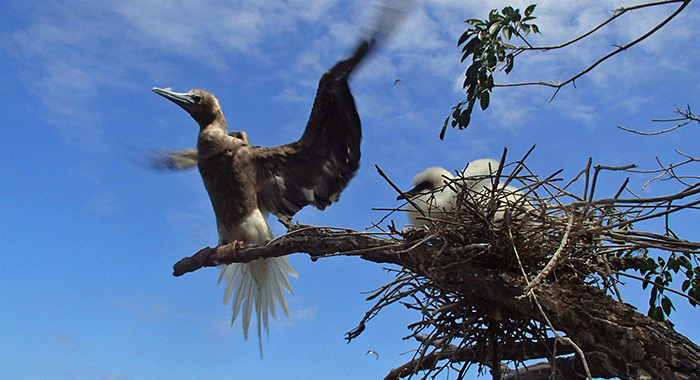(Scroll for video)
A new short film titled “Grenadines Seabirds: Uniting Land, Air, and Sea” journeys through the remote and uninhabited islands of the Grenadines to explore the secret lives of seabirds, their importance to the ecosystem, threats to their survival, and what we can do to help.
The U.S.-based non-profit organisation, Environmental Protection in the Caribbean (EPIC), released the film, which travels through land, air, and sea with these remarkable and uniquely adapted birds.
The trans-boundary Grenadine islands harbour tens of thousands of seabirds, making the region crucial for the protection of these threatened birds.
Seabirds alone possess the unique ability to nest on land, fly vast distances, and fish from the sea.
This makes them especially vulnerable to threats from human activities in a variety of environments.
Seabird Biologist, Juliana Coffey, has been collecting footage of seabirds through the Grenadines for the past nine years.
“Seabirds are notoriously difficult to film”, she said, “many people will never have the opportunity to observe seabirds at their remote island habitats or out at sea. It is because of this that we wanted to feature them in this short film, so that their story in this region does not remain untold.”
The film is part of an on-going initiative called “Conservation of Key Offshore Island Reserves”, which aims to develop long-term strategies to protect Grenadine seabirds.
The project is a partnership between EPIC and St. Vincent-based organisation Science Initiative for Environmental Conservation and Education (SCIENCE). The initiative is made possible with funding from the U.S. Fish and Wildlife Service and USAID.
Until now, seabirds have been afforded limited conservation and protection in the region due to lack of financial resources, confounded by the remoteness and inaccessibility of nesting islands. Seabirds, in fact, are rapidly declining worldwide from factors such as development, climate change, invasive predators and declines in forage fish.
The Grenadines are no exception and are further threatened by livestock grazing, traditional seabird harvests and an overall absence of conservation and management strategies.
So why save our seabirds? The Grenadine archipelago consists of over 50 islands, islets, and cays that provide important nesting, resting and feeding habitat for more than 20 species of seabirds.
Not only are seabirds important indicators of ocean health and climate change, but they have been an important part of Grenadines’ culture and livelihood since people arrived in the region.
Artefacts recovered from early Amerindian sites depict seabirds on pottery as well as document the use of seabird bones and feathers in tools. Today, they continue to be represented in art and folklore.
In addition, for those dependent upon a maritime economy, such as fisher folk, seabirds assist with navigation, fish finding, and interpreting weather patterns. The potential for revenue generated from seabird tourism has proven to be valuable in other areas and is an underdeveloped opportunity for those looking to diversify their livelihoods in the Grenadines.







Its interesting that at the beginning of this film its states “the Grenadine islands of Grenada and St. Vincent and the Grenadines”. Are you saying that the Grenadine islands belongs to Grenada? Where did you learn Caribbean history?
The Grenadines are divided into 2 nations – Grenada has about 30+ Grenadine islands -Carriacou and PM for example. The Grenadine Islands are located on the Grenada Bank, which stretches from Bequia channel to south of Grenada.
No that is not they are trying to say they are saying the grenadine island of Grenada meaning carracou and petite martinique and the grenadine island of St. Vincent which is bequia to union island.
Our once happy warriors stand opposite ready, even though we’re only families apart.
Thank you Juliana, thank you Grenada, and thank you Saint Georges for your input on the plastic.
Very good & informative video. ^, :-bd
Its made me smile hearing someone talk about knowing or not knowing Caribbean history, Hehehehehehe, it so happens that The Grenadines was once part of Grenada, Yes Grenada, hence the word Grenad-ines. So go learn up on the Caribbean History, Check Late 1700s, say from 1775 onwards.